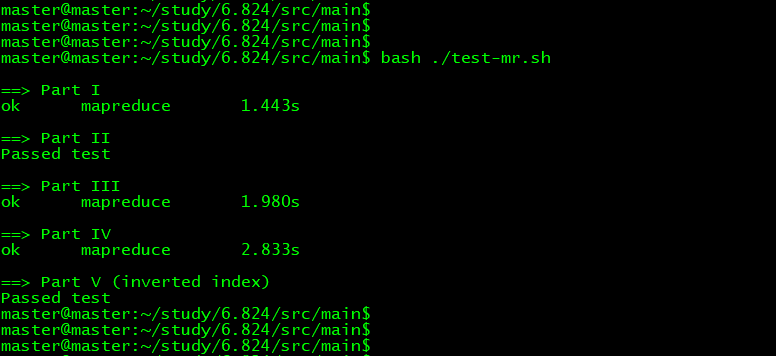partV
创建文档反向索引。word -> document
与 前面做的 单词统计类似,这个是单词与文档位置的映射关系。
mapF 文档解析相同,返回信息不同而已。
reduceF 返回归约都的字符串,返回document 切片 转成 string 使用 strings.join 。
master@master:~/study/6.824/src/main$ go run ii.go master sequential pg-*.txt
ii.go:9:8: cannot find package "mapreduce" in any of:
/usr/local/go/src/mapreduce (from $GOROOT)
/home/master/go/src/mapreduce (from $GOPATH)

找不到 mapReduce 包,把mapReduce 添加到 path
$ cd 6.824
$ export "GOPATH=$PWD" # go needs $GOPATH to be set to the project's working directory

bash ./test-ii.sh 直接测试程序结果。

ii.go
package main import ( "os" "strings" "unicode" "strconv" ) import "fmt" import "mapreduce" // The mapping function is called once for each piece of the input. // In this framework, the key is the name of the file that is being processed, // and the value is the file's contents. The return value should be a slice of // key/value pairs, each represented by a mapreduce.KeyValue. func mapF(document string, value string) (res []mapreduce.KeyValue) { // Your code here (Part V). f := func(c rune) bool { return !unicode.IsLetter(c) } rst := make([]mapreduce.KeyValue, 0) keys := strings.FieldsFunc(value, f) for _, key := range keys { kv := mapreduce.KeyValue{ Key: key, Value:document} rst = append(rst, kv) } return rst } // The reduce function is called once for each key generated by Map, with a // list of that key's string value (merged across all inputs). The return value // should be a single output value for that key. func reduceF(key string, values []string) string { // Your code here (Part V). vm := make(map[string]string) var rst []string for _, value := range values { if _, ok := vm[value]; !ok { rst = append(rst, value) vm[value] = value } } vl := strings.Join(rst, ",") return strconv.Itoa(len(rst)) + " " + vl } // Can be run in 3 ways: // 1) Sequential (e.g., go run wc.go master sequential x1.txt .. xN.txt) // 2) Master (e.g., go run wc.go master localhost:7777 x1.txt .. xN.txt) // 3) Worker (e.g., go run wc.go worker localhost:7777 localhost:7778 &) func main() { if len(os.Args) < 4 { fmt.Printf("%s: see usage comments in file\n", os.Args[0]) } else if os.Args[1] == "master" { var mr *mapreduce.Master if os.Args[2] == "sequential" { mr = mapreduce.Sequential("iiseq", os.Args[3:], 3, mapF, reduceF) } else { mr = mapreduce.Distributed("iiseq", os.Args[3:], 3, os.Args[2]) } mr.Wait() } else { mapreduce.RunWorker(os.Args[2], os.Args[3], mapF, reduceF, 100, nil) } }
上面LAB1 五部分一起测试。

LABI 完成。




